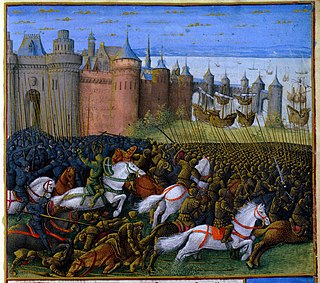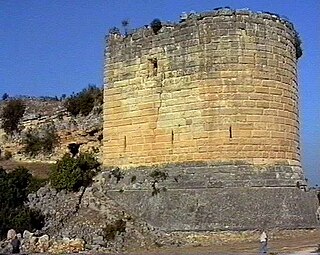Related Research Articles
Year 1252 (MCCLII) was a leap year starting on Monday of the Julian calendar.

Odo of Burgundy, in French Eudes de Bourgogne, was the Count of Nevers, Auxerre and Tonnerre and son of Hugh IV, Duke of Burgundy and Yolande of Dreux.
Byzantine art comprises the body of Christian Greek artistic products of the Eastern Roman (Byzantine) Empire, as well as the nations and states that inherited culturally from the empire. Though the empire itself emerged from the decline of Rome and lasted until the Fall of Constantinople in 1453, the start date of the Byzantine period is rather clearer in art history than in political history, if still imprecise. Many Eastern Orthodox states in Eastern Europe, as well as to some degree the Islamic states of the eastern Mediterranean, preserved many aspects of the empire's culture and art for centuries afterward.

The Melisende Psalter is an illuminated manuscript commissioned around 1135 in the crusader Kingdom of Jerusalem, probably by King Fulk for his wife Queen Melisende. It is a notable example of Crusader art, which resulted from a merging of the artistic styles of Roman Catholic Europe, the Eastern Orthodox Byzantine Empire and the art of the Armenian illuminated manuscript.

Saidnaya is a city located in the mountains, 1,500 m (4,900 ft) above sea level, 27 km (17 mi) north of the city of Damascus in Syria. It is the home of a Greek Orthodox monastery traditionally held to have been founded by Byzantine emperor Justinian I, and where a renowned icon of the Virgin Mary is revered by both Christians and Muslims to this day. The town is noted for the large number of Aramaic speakers, along with nearby Maaloula and few smaller towns nearby such as Maarat Saidnaya. According to the Syria Central Bureau of Statistics (CBS), Saidnaya had a population of 25,194 in the 2004 census.

Crusader art or the art of the Crusades, meaning primarily the art produced in Middle Eastern areas under Crusader control, spanned two artistic periods in Europe, the Romanesque and the Gothic, but in the Crusader kingdoms of the Levant the Gothic style barely appeared. The military crusaders themselves were mostly interested in artistic and development matters, or sophisticated in their taste, and much of their art was destroyed in the loss of their kingdoms so that only a few pieces survive today. Probably their most notable and influential artistic achievement was the Crusader castles, many of which achieve a stark, massive beauty. They developed the Byzantine methods of city-fortification for stand-alone castles far larger than any constructed before, either locally or in Europe.

An-Nasir Yusuf, fully al-Malik al-Nasir Salah al-Din Yusuf ibn al-Aziz ibn al-Zahir ibn Salah al-Din Yusuf ibn Ayyub ibn Shazy, was the Ayyubid Emir of Syria from his seat in Aleppo (1236–1260) and the Sultan of the Ayyubid Empire from 1250 until the sack of Aleppo by the Mongols in 1260.

Burchard of Mount Sion, was a German priest, Dominican friar, pilgrim and author probably from Magdeburg in northern Germany, who travelled to the Middle East at the end of the 13th century. There he wrote his book called: Descriptio Terrae Sanctae or "Description of the Holy Land" which is considered to be of "extraordinary importance".

John I de Montfort, Count of Montfort from 1241 to 1249, son of Amaury de Montfort, count of Montfort, and of Béatrice of Burgundy. In 1248 he joined Louis IX's crusader fleet. Once the fleet arrived at Limassol, it was scattered by fierce storms and was forced to wait there to regroup. John died of sickness, while awaiting the rest of Louis's forces in Cyprus.
Al-Malik al-Salih Imad al-Din Ismail bin Saif al-Din Ahmad better known as al-Salih Ismail was the Ayyubid sultan based in Damascus. He reigned twice, once in 1237 and then again from 1239 to 1245.

The Cathedral of Our Lady of Tortosa was a Catholic cathedral in the city of Tartus, Syria. Erected during the 12th century, it has been described by historians as "the best-preserved religious structure of the Crusades." The cathedral was popular among pilgrims during the Crusades because Saint Peter was said to have founded a small church there dedicated to the Virgin Mary. After it was captured by the Mamluks, the cathedral was turned into a mosque. Today, the building serves as the National Museum of Tartus.

The siege of Tyre took place from 12 November 1187 to 1 January 1188. An army commanded by Saladin made an amphibious assault on the city, defended by Conrad of Montferrat. After two months of continuous struggle, Saladin dismissed his army and retreated to Acre.

Koz Castle, or Kürşat Castle is a castle in the Altınözü district of the Hatay Province of Turkey, built on a small hill where the Kuseyr Creek starts. It was built by the Principality of Antioch out of ashlar. The castle used to have a gate to the north, but this gate no longer exists and the eastern side of the castle has been leveled, with some original barns left. Some bastions of the castle stand to this day.

St Andrew's Church is a Greek Catholic (Melkite) church. Built in 1765, it is located in the old city of Acre, at Philippe Auguste street, north of the Templars tunnel in modern-day Israel. It is named after one of the twelve apostles of Jesus. The church was built on the remains of a Crusader church. The church is still used today and is known for its beautiful interior, icons, and ornate decoration.

Geoffrey V, nicknamed le Trouillard, was the Lord of Joinville from 1190 until his death in late 1203 or early 1204. He was also the hereditary seneschal of the County of Champagne. He went on both the Third Crusade (1189–90) and the Fourth Crusade (1202–04), where he died.
The Rothelin Continuation is an anonymous Old French prose history of the Crusades and the Crusader states between 1229 and 1261. It is one of the most important sources for the period it covers, which includes the Barons' Crusade (1239–1241), the Seventh Crusade (1248–1254) and the first Mongol raid into Palestine (1260).
Thietmar or Dithmar was a German Christian pilgrim who visited the Holy Land in 1217–1218 and wrote an account of his travels, the Liber peregrinationis.

John of Antioch, also known as Harent of Antioch, was a 13th-century Old French writer of Outremer who made important translations from Latin. He translated Cicero, Boethius, the Otia imperialia and possibly the rule of the Knights Hospitaller. His original writing consists of an epilogue to Cicero and some additional chapters appended to the Otia.

The Acre Bible is a partial Old French version of the Old Testament, containing both new and revised translations of 15 canonical and 4 deuterocanonical books, plus a prologue and glosses. The books are Genesis, Exodus, Leviticus, Numbers, Deuteronomy, Joshua, Judges, 1 and 2 Samuel, 1 and 2 Kings, Judith, Esther, Job, Tobit, Proverbs, 1 and 2 Maccabees and Ruth. It is an early and somewhat rough vernacular translation. Its version of Job is the earliest vernacular translation in Western Europe.
References
- ↑ TROSKY, Susan M., Contemporary Authors: A Bio-Bibliographical Guide to Current Writers in Fiction, General Nonfiction, Poetry, Journalism, Drama, Motion Pictures, Television, vol. 127, page 142, Gale 1989, ISBN 978-0-8103-1952-3
- ↑ Genealogy of Charles L. Whitham
- ↑ Two indices for this book are located on the Cambridge University Press website. Go to http://www.cambridge.org/us/catalogue.asp?isbn=0521835836 Note: On the far left side of the page on that site, there is a box that says: resources and resolutions. Click on view material, which will link to each index as a pdf for downloading.